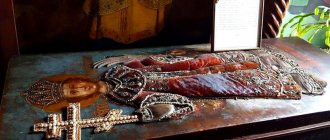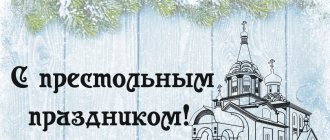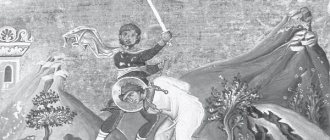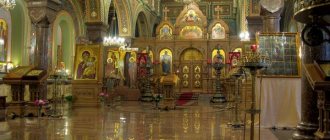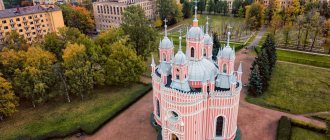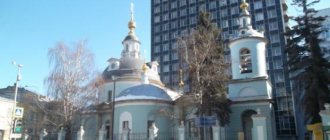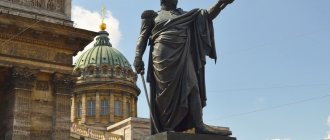Mir
Russia Moscow Temple of St. Gregory of Neocaesarea (Moscow) Map loading in progress...
{"format":"leaflet","minzoom":false,"maxzoom":false,"limit":50,"offset":0,"link":"all","sort":[""], "order":[],"headers":"show","mainlabel":"","intro":"","outro":"","searchlabel":"\u2026 \u0441\u043b\u0435\ u0434\u0443\u044e\u0449\u0438\u0435 \u0440\u0435\u0437\u0443\u043b\u044c\u0442\u0430\u0442\u044b","default":"","import-annotation":false,"width ":"auto","height":"350px","centre":{"text":"","title":"""link":"","lat":55.7374999999999971578290569595992565155029296875,"lon": 37.61943999999999732608557678759098052978515625,"icon":""},"title":"","label":"","icon":"","lines":[],"polygons":[], "circles":[ ],"rectangles":[],"copycoords":false,"static":false,"zoom":8,"defzoom":14,"layers":["OpenStreetMap"],"image layers":[] ,"overlays":[],"resizable":false,"fullscreen":true,"scrollwheelzoom":true,"cluster":false,"clustermaxzoom":9,"clusterzoomonclick":true,"clustermaxradius":80, "clusterspiderfy":true,"geojson":"","clicktarget":"","showtitle":true,"hidenamespace":false,"template":"","userparam":"","activeicon": "","pagelabel":false,"ajaxcoordproperty":"","ajaxquery":"","locations":[{"text":"\u003Cb\u003E\u003Ca href=\"/palomnik/%D0% A5%D1%80%D0%B0%D0%BC_%D0%93%D1%80%D0%B8%D0%B3%D0%BE%D1%80%D0%B8%D1%8F_%D0%9D% D0%B5%D0%BE%D0%BA%D0%B5%D1%81%D0%B0%D1%80%D0%B8%D0%B9%D1%81%D0%BA%D0%BE%D0% B3%D0%BE_(%D0%9C%D0%BE%D1%81%D0%BA%D0%B2%D0%B0)\» title=\»\u0425\u0440\u0430\u043c \u0413\u0440\ u0438\u0433\u043e\u0440\u0438\u044f \u041d\u0435\u043e\u043a\u0435\u0441\u0430\u0440\u0438\u0439\u0441\u043a\u043e\u0433\u04 3e (\u041c\u043e\u0441\u043a \u0432\u0430)\»\u003E\u0425\u0440\u0430\u043c \u0413\u0440\u0438\u0433\u043e\u0440\u0438\u044f \u041d\u0435\u043e\u043a\u04 35\u0441\u0430\u0440\ u0438\u0439\u0441\u043a\u043e\u0433\u043e (\u041c\u043e\u0441\u043a\u0432\u0430)\u003C/a\u003E\u003C/b\u003E\u003Chr /\u003E\u0 03Ca href=\" /palomnik/%D0%A1%D0%B2%D0%BE%D0%B9%D1%81%D1%82%D0%B2%D0%BE:%D0%90%D0%BD%D0%BD%D0 %BE%D1%82%D0%B0%D1%86%D0%B8%D1%8F\" title=\"\u0421\u0432\u043e\u0439\u0441\u0442\u0432\u043e:\u0410\u043d\ "" 425\u0440\u0430 \u043c \u0441\u0432\u044f\u0442\u0438\u0301\u0442\u0435\u043b\u044f \u0413\u0440\u0438\u0433\u043e\u0301\u0440\u0438\u044f \u041d\u0435\u043e\u043a\u0435 \u0441\u0430\u0440\u0438\u0301\u0439\u0441\u043a\u003Cspan class=\»smw-highlighter\» data-type=\»2\» data-state=\»persistent\» data-title=\ »\u0418\u043d\u0444\u043e\u0440\u043c\u0430\u0446\u0438\u044f\» title=\»\u0425\u0440\u0430\u043c \u0441\u0432\u044f\u0442\u0438\ u0301\u0442\ u0435\u043b\u044f \u0413\u0440\u0438\u0433\u043e\u0301\u0440\u0438\u044f \u041d\u0435\u043e\u043a\u0435\u0441\u0430\u0440\u0 438\u0301\u0439\u0441\u043a\ u043e\u0433\u043e \u0432 \u0414\u0435\u0301\u0440\u0431\u0438\u0446\u0430\u0445 \u2014 \u043f\u0440\u0430\u0432\u043e\u0441\ u043b\u0430\u0432\u043d\u044b\ u0439 \u0445\u0440\u0430\u043c \u041c\u043e\u0441\u043a\u0432\u043e\u0440\u0435\u0446\u043a\u043e\u0433\u043e \u0431\u043b\u 0430\u0433\u043e\u0447\u0438\ u043d\u0438\u044f \u041c\u043e\u0441\u043a\u043e\u0432\u0441\u043a\u043e\u0439 \u0433\u043e\u0440\u043e\u0434\u0441\u043a\u0 43e\u0439\u0435\u043f\u0430\ u0440\u0445\u0438\u0438 \u0420\u0443\u0441\u0441\u043a\u043e\u0439 \u041f\u0440\u0430\u0432\u043e\u0441\u043b\u0430\u0432\u0 43d\u043e\u0439\u0426\u0435\ u0440\u043a\u0432\u0438. \u0425\u0440\u0430\u043c \u044f\u0432\u043b\u044f\u0435\u0442\u0441\u044f \u043f\u0430\u043c\u044f\u0442\u043d\u0438\u043a\ u043e\u043c\u0430\u0440\u0445 XVII \u0432\u0435\u043a\u0430, \u0440\u0430\u0441\u043f\u043e\u043b\u043e\u04 36\u0435\u043d\u0432\u0440 \u0430\u0439\u043e\u043d\u0435 \u042f\u043a\u0438\u043c\u0430\u043d\u043a\u0430 \u0433\u043e\u0440\u043e\u0434\u0430 \u041c \u043e\u0441\u043a\u0432\u044b . - - f\u0442\u0438\u0442\u0435 \u043b\u044f \u0413\u0440\u0438\u0433\u043e\u0440\u0438\u044f \u041d\u0435\u043e\u043a\u0435\u0441\u0430\u0440\u0438\u0439\ u0441\u043a\u043e\u0433\u043e .\"\u003E\u003Cspan class=\"smwtext\"\u003E \u2026 \u003C/span\u003E\u003Cspan class=\"smwttcontent\"\u003E"'\u0425\u0440\u0430\u043c \u0441\u0432\ u044f\u0442\u0438\u0301\u0442\u0435\u043b\u044f \u0413\u0440\u0438\u0433\u043e\u0301\u0440\u0438\u044f \u041d\u0435\u043e\u0 43a\u0435\u0441\u0430\u0440\ u0438\u0301\u0439\u0441\u043a\u043e\u0433\u043e \u0432 \u0414\u0435\u0301\u0440\u0431\u0438\u0446\u0430\u0445"' \u2014 \u043 f\u0440\u0430\u0432\u043e\ u0441\u043b\u0430\u0432\u043d\u044b\u0439 \u0445\u0440\u0430\u043c \u041c\u043e\u0441\u043a\u0432\u043e\u0440\u0435\u0446\u0 43a\u043e\u0433\u043e\u0431\ u043b\u0430\u0433\u043e\u0447\u0438\u043d\u0438\u044f \u041c\u043e\u0441\u043a\u043e\u0432\u0441\u043a\u043e\u0439 \u0433\u0 43e\u0440\u043e\u0434\u0441\ u043a\u043e\u0439 \u0435\u043f\u0430\u0440\u0445\u0438\u0438 \u0420\u0443\u0441\u0441\u043a\u043e\u0439 \u041f\u0440\u0430\u 0432\u043e\u0441\u043b\u0430\ u0432\u043d\u043e\u0439 \u0426\u0435\u0440\u043a\u0432\u0438. \u0425\u0440\u0430\u043c \u044f\u0432\u043b\u044f\u0435\u0442\u0441\u044f \u043f\u0430\u043c\u044f\u0442\u043d\u0438\u043a\ u043e\u043c\u0430\u0440\u0445 XVII \u0432\u0435\u043a\u0430, \u0440\u0430\u0441\u043f\u043e\u043b\u043e\u04 36\u0435\u043d\u0432\u0440 \u0430\u0439\u043e\u043d\u0435 \u042f\u043a\u0438\u043c\u0430\u043d\u043a\u0430 \u0433\u043e\u0440\u043e\u0434\u0430 \u041c \u043e\u0441\u043a\u0432\u044b . [https://azbyka.ru/otech nik/Grigorij_Chudotvorets/ c\u0432\u044f\u0442\u0438\u0442\u0435\u043b\u044f \u0413\u0440\u0438\u0433\u043e\u0440\u0438\u044f \u041d\u0435\u043e\u043a\ u0435\u0441\u0430\u0440\ u0438\u0439\u0441\u043a\u043e\u0433\u043e].\u003C/span\u003E\u003C/span\u003Erets/ c\u0432\u044f\u0442\u0438\u0442\u0435\u043b\u044f \u0413\u0440\ u0438\u0433\u043e\u0440\u0438\u044f \u041d\u0435\u043e\u043a\u0435\u0441\u0430\u0440\u0438\u0439\u0441\u043a\u043e\u0433\u04 3e].,"title":" \u0425\u0440\u0430\u043c \u0413\u0440\u0438\u0433\u043e\u0440\u0438\u044f \u041d\u0435\u043e\u043a\u0435\u0441\u0430\u0440\ u0438\u0439\u0441\u043a\u043e \u0433\u043e (\u041c\u043e\u0441\u043a\u0432\u0430)","link":"","lat":55.7374999999999971578290569595992565155029296875,"lon":37.61943 999999999732608557678759098052978515625,"icon":""}],"imageLayers ":[]}
55.737552; 37.619378
Russia, Moscow, Bolshaya Polyanka street, 29A
Moscow
Russia
Telephone:
8 (495) 959-00-11
Church of St. Gregory of Neocaesarea in Derbitsy
- Orthodox church of the Moskvoretsky deanery of the Moscow city diocese of the Russian Orthodox Church. The temple is an architectural monument of the 17th century, located in the Yakimanka district of Moscow. The main shrine is the relics of St. Gregory of Neocaesarea.
History[edit]
The Church of St. Gregory of Neocaesarea in Derbitsy begins its historical existence in ancient times. It was originally made of wood. It was built by Grand Duke Vasily II (Dark) in gratitude for the miraculous deliverance from Tatar captivity. While in the Horde, the prince made a vow to God: to build a church on the spot from which he would see the walls of the Kremlin, in honor of the saint, whose memory would be celebrated that day, which happened on November 30, 1445, on the day of remembrance of St. Gregory the Wonderworker. The wooden temple existed until the end of the 17th century. Today, in its place, with the blessing of His Holiness Patriarch Alexy II, a wooden chapel-monument was built in honor of the All-Merciful Savior. The chapel and the historical phrase “in Derbitsy”, i.e. in a forested, swampy place, remind us of those distant times.
In 1668-79, next to the wooden one, a majestic stone church was erected through the diligence of the Tsar’s confessor, Archpriest Andrei Savinov, at the expense of Tsar Alexei Mikhailovich. The start of construction was blessed by His Holiness Patriarch Nikon, and the completed church was consecrated by His Holiness Patriarch Joachim in the presence of Tsar Theodore Alekseevich. The temple was built by the best architects of that time, Karp Guba and Ivan Kuznechik. In its architecture, the church belongs to the Moscow type of five-domed churches with a hipped bell tower. The facades are decorated with tiles with intricate floral patterns “peacock's eye”, made by the famous potter Stepan Polubes. Modern people are somewhat surprised by the bright colors of the external decoration of the temple. But it was Tsar Alexei Mikhailovich, as historical sources tell us, who ordered the walls of the temple to be “painted with red lead into the brick”, “to intertwine the arrows of the tent”, “and to paint them with turquoise and whitewash”. The church was so magnificent in appearance, so fully consistent with people’s ideas of beauty, that it was popularly called “Red,” that is, beautiful. The icons for the iconostasis were painted by royal isographers, headed by the famous Simon Ushakov. His Mother of God of Eleusa-Kykkos from the local row of the iconostasis is constantly exhibited in the Tretyakov Gallery.
In 1671, Tsar Alexei Mikhailovich married Natalya Kirillovna Naryshkina in the temple, and in 1672, the infant Peter I, the future Emperor of Russia, was baptized here. Today, the font in which, according to legend, the prince was baptized, is carefully preserved in the temple. The fact that the rector of the temple was the royal confessor explains that it was here that these important historical events took place. For a long time the temple was given the status of a court. And today the crosses of the five heads of the church, crowned with royal crowns, remind us that the temple was constantly visited by sovereigns. Services in the church were performed by His Holiness the Patriarchs and Metropolitans of Moscow.
In 1812, Napoleon, enchanted by the beauty of the church, regretted that he could not put it on the palm of his hand and move it to Paris, and during the raging fire, French soldiers carried water in buckets and watered the temple to save it from fire.
At the beginning of the twentieth century. Grand Duchess Elizaveta Feodorovna loved to pray in the church.
In 1939, the temple was closed, dilapidated, and desecrated. All his shrines and property were plundered. The last rector, Archpriest Boris Ivanovsky, was shot at the Butovo training ground. Today he is canonized by the Church with the rank of hieromartyrs (December 10). His pectoral cross is preserved in the temple as a relic.
Since 1994, services have been resumed in the temple.
In 1996, the temple was consecrated by His Holiness Patriarch of Moscow and All Rus' Alexy II.
Today, through the efforts of the parish community and the rector, Bishop Jerome (Chernyshov), the temple has acquired its former splendor. For its picturesque beauty, people again call the church “Red”.
Church of St. Gregory of Neocaesarea - an architectural monument
The Church of Gregory of Neocaesarea in Derbitsy is an Orthodox church. It is located in Moscow in the Yakimanka district. It belongs to the Moskvoretsky deanery of the Moscow city diocese of the Russian Orthodox Church. The temple is recognized as an architectural monument of the 17th century.
Moscow, Russia. Bolshaya Polyanka street. Orthodox Church of Gregory of Neocaesarea. The Church of St. Gregory of Neocaesarea is recognized as an architectural and cultural monument and is protected by the state
The temple was erected in honor of St. Gregory of Neocaesarea. He became famous for his ascetic life and fight against the pagans. In 264, Bishop Gregory participated in the Antioch Local Council, convened against the heretic Paul of Samosata, who falsely taught about the Holy Trinity and denied the Divine dignity of Jesus Christ.
He is the author of many theological works and a Creed, which is highly revered in the Orthodox world and is called the Creed of Gregory the Wonderworker.
Activities of the parish[edit]
Church iconostasis
For many years, the social, youth and catechetical activities of the parish were carried out as part of work with military personnel. The parish provided care for: the General Staff motor depot, the security and support battalion of the headquarters of the Moscow Military District, and the Separate 154th Commandant Regiment. Youth activities: supported military personnel are young people. Catechetical activity: the Divine Liturgy is celebrated weekly in the regiment. Bishop Jerome conducts lectures, conversations, and quizzes with military personnel on the history of our Fatherland and the Church. On the days of the oath, farewell to the reserve, the beginning and end of training periods, the days of the regiment, Vladyka Jerome is present, who blesses and gives instructions. Social activities: mainly socially vulnerable, unemployed young people serve in the Army. The parish solves many of their social problems. Military personnel who distinguish themselves in competitions of high military skill receive a superior's scholarship and a vacation ticket to their homeland. Meals with sweets are organized for all military personnel on holidays. They are given gifts. Those who retire from the reserve are provided with assistance in finding employment and enrolling in universities.
In addition, from the first days of the formation of the parish community, other large social work has been carried out. For 15 years, the parish has been providing assistance to state social institutions. Thus, the parish regularly helps the Research Institute of Emergency Pediatric Surgery and Traumatology, Children's City Clinical Hospital No. 20 named after. K.A.Timiryazev - 119180, Moscow, st. Bolshaya Polyanka, 20.
Also, assistance is constantly provided to the “Neurological Clinic on Polyanka” and the “Multidisciplinary Medical Complex for adults and children on Polyanka” - 119180, Moscow, st. Bolshaya Polyanka, 51A/9; tel..
Help consists of performing church Sacraments (Unction, Confession, Communion), conducting conversations and lectures.
The parish has a patronage service, a charitable parish canteen for the poor, and a point for distributing clothing and food to the poor.
Doctors - parishioners of the temple - conduct consultations in the parish premises at the request of low-income parishioners in need of medical care.
After the Liturgy on Sundays and holidays, white bread is distributed to all those present from low-income families.
On Patronal Feasts, Christmas, Easter and other major holidays, a meal with sweets is organized for elderly and low-income parishioners.
The number of social service clients is constantly changing.
The number of permanent volunteer employees is at least 10 people, but if necessary, at the call of the rector, a significant number of people can be involved in carrying out social events.
The parish helps needy individuals at the church. Help is provided to lonely and sick parishioners, the disabled, needy parish members, and parishioners with many children. Financial assistance, assistance with lunches, food and gifts are provided. Social service employees help disabled and sick parishioners to get to church and help them during services.
Much assistance was provided to those affected by forest fires. A money collection was held in favor of fire victims. In addition, many sets of blankets and pillows were purchased for people who have lost their homes.
Working with youth in the parish of St. Gregory of Neocaesarea is closely connected with religious education and educational activities. The priority is to attract young people not only to theory, but also to practical participation in liturgical and extra-liturgical activities. And the altar servers, and the subdeacons, and the singers in the church are exclusively young people.
The Orthodox cultural and educational center constantly holds concerts, after which young people exchange impressions over a cup of tea in a friendly conversation.
The international public movement “Love and Fidelity,” created with the blessing of His Holiness Patriarch Kirill of Moscow and All Rus', regularly held youth missionary seminars. After the business meetings, the conversation continued in the refectory.
Youth pilgrimage trips to holy places are conducted, during which people not only gain new impressions and learn information, but also get to know each other better and unite into a community living by common interests.
For 15 years, all the work on catechetical activities at the Church of St. Gregory of Neocaesarea on Bolshaya Polyanka in Moscow was conducted by the rector of the church, hieromonk, abbot, Archimandrite Jerome. Currently, having become a bishop, Vladyka Jerome continued this very necessary and important activity. He is significantly assisted by the clergy of the temple: Archpriest Theodore Malakhov, Deacon Vladislav Astafiev, as well as the assistant rector, Candidate of Historical Sciences P.M. Zolotarev, Candidate of Sociological Sciences nun Alexia (Perevedentseva), regent Nikolai Belov, bell ringer Evgeniy Fokin. There are various circles at the church: altar boys, church singing, bell ringers, subdeacons. Since 2008, a Sunday school for children has been operating. Catechetical discussions are held for adults.
There is an Orthodox library with a rich selection of books, in which thematic conversations and discussions of what they have read are held with visitors.
There is a beautifully decorated classroom where, in silence, surrounded by portraits of church teachers and theologians, students easily perceive information on church subjects.
Assistant rector Pavel Mitrofanovich Zolotarev gives lectures in secondary schools in Moscow.
Regular services are held in the Church of St. Gregory of Neocaesarea on Bolshaya Polyanka
The rector of the Church of St. Gregory of Neocaesarea on Bolshaya Polyanka in Moscow is Bishop Jerome (Chernyshev), Deacon Vladislav Astafiev, and the male choir is led by regent Nikolai Belov.
Regular services, all sacraments and services are held in the church. As for the schedule, services in the temple are held on Saturdays, Sundays and holidays:
- Saturday: 09:00 - Matins, Liturgy. 17:00 - all-night vigil;
- on Sunday: 09:30 - liturgy.
Parish of the Church of St. Gregory of Neocaesarea in Derbitsy Official website
The schedule of services is constantly changing and must be checked on the Temple website.
Map of the location of the parish of the Church of St. Gregory of Neocaesarea in Derbitsy, Moscow Diocese of the Russian Orthodox Church.
The parish of the Church of St. Gregory of Neocaesarea in Derbitsy of the Moscow Diocese of the Russian Orthodox Church is located at Bolshaya Polyanka Street, 29-A. Contacts: Phone. Email:
It is easy to get to, as it is located in a densely populated area of Moscow, while the Polyanka metro station is located next to the temple, and Bolshaya Yakimanka Street also runs through.
By leaving a comment, you accept the user agreement
Shrines[edit]
Revered copy of the Bogolyubsk Icon of the Mother of God
- The relics of St. Gregory of Neocaesarea, which were handed over by Metropolitan Anthony (Bloom) of Sourozh and which were solemnly transferred in 1998 and placed in a shrine.
- Particles of the relics of: Saints Gregory the Theologian, Mitrofan of Voronezh, Tikhon of Zadonsk, Joasaph of Belgorod, Demetrius of Rostov, Philaret and Innocent of Moscow; Great Martyr Demetrius of Thessalonica, Great Martyr and Healer Panteleimon; Saints Sergius of Radonezh, Jerome of Stridon, Pimen the Great, Nile of Stolbensky, David and Athanasius of Serpukhov, Holy Fathers of the Kiev-Pechersk; Holy Blessed Prince Alexander Nevsky; Blessed Matrona of Moscow; Holy Righteous Simeon of Verkhoturye.
- Bogolyubskaya Icon of the Mother of God.
- Particle of the Life-Giving Cross of the Lord
During Soviet times, the temple was desecrated and looted
In the twentieth century, the Church of St. Gregory of Neocaesarea did not escape the fate of other churches of the Russian Orthodox Church. In 1922, all valuables stored in the cathedral were confiscated. In 1930, the Moscow City Council decided to demolish the tented bell tower of the church.
This was required to widen the sidewalk. Historians managed to stop the demolition, but they cut a through passage through the bell tower.
Temple of the Saint. Gregory of Neocaesarea in the 1930s. A passage through the bell tower is visible, cut to widen the sidewalk
Repressions affected the temple clergy. One bishop and five priests became martyrs. It is quite possible that the pogrom of a cultural monument of world significance and the destruction of the priests who served in it occurred due to the status of the court church.
In addition, it should be noted that during the years of the Revolution, His Holiness Patriarch Tikhon served here. The priests of the temple did not deviate into the renovationist schism and forever remained faithful to the Russian Orthodox Church.
1938
this year the Moscow City Council closed the temple and transferred its buildings to cultural needs
In 1938, the Moscow City Council decided to close the church and use its building for cultural purposes. All icons from the temple were transferred to museums. This is how the most valuable icon of the Mother of God of Eleusa-Kykkos Simona Ushakova ended up in the Tretyakov Gallery.
Temple of the Saint. Gregory of Neocaesarea 1975. After restoration, the church became the location of the All-Union Production and Art Plant named after. Vuchetich"
In 1965, the temple was restored. It was placed under state protection as a historical and cultural monument. The All-Union Production and Art Plant named after Vuchetich began operating here.
In addition, there was also a batik production workshop here. In the early 90s, the church was in a deplorable state: there was no electrical wiring, no floors and no windows, and the heating did not work.
Church in the War of 1812
During the events of 1812, the temple on Polyanka of St. Gregory of Neocaesarea also distinguished itself. If in relation to other churches the French indulged in acts of vandalism and burned many religious buildings along with ordinary houses, then in this case they behaved unprecedentedly. Namely: in the temple of Gregory of Neocaesarea there were soldiers on duty, whose task was to protect the building from looting and fire. French soldiers carried water in buckets to protect it from damage by the fire that devastated the capital. Napoleon lamented about this, saying that if only it were possible, he would put this church in the palm of his hand and take it to Paris.
